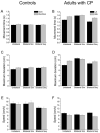Influence of task on interlimb coordination in adults with cerebral palsy
- PMID: 20875516
- PMCID: PMC4005393
- DOI: 10.1016/j.apmr.2010.07.015
Influence of task on interlimb coordination in adults with cerebral palsy
Abstract
Objective: To examine movement time and kinematic properties of unilateral and bilateral reaching movements in adults with cerebral palsy (CP), focusing on how different types of bilateral movements, simultaneous or sequential, may influence interlimb coordination.
Design: Quantitative study using between-group repeated-measures analyses.
Setting: Motor control laboratory at a research university.
Participants: Adults with hemiplegic CP (n=11; mean age ± SD, 33±10y; 4 men) and age-matched controls (mean age ± SD, 32±9y; 4 men).
Interventions: Not applicable.
Main outcome measures: Movement time (MT), maximum deviation from a straight trajectory to the target, and peak speed.
Results: Although adults with hemiplegic CP showed strong unilateral deficits, bilateral simultaneous reaching movements were temporally and spatially coupled. Movement of the less affected arm slowed to match the movement of the more affected arm. In contrast, bilateral sequential movements improved MTs of the less affected and more affected arms.
Conclusions: Bilateral sequential movements were conducive to faster MT compared with unilateral or bilateral simultaneous movements. Training that includes bilateral sequential movements may be beneficial to adults with hemiplegic CP. Upper-limb movements are coordinated in a variety of ways to perform routine bilateral tasks. Some bilateral tasks, such as stacking boxes, require more symmetric movements of the upper limbs. Other bilateral tasks, such as opening the refrigerator with 1 hand while placing an item on the shelf with the other hand, emphasize coordinated sequential action between upper limbs. Despite the prevalence of integrative upper-limb use, the control of different forms of bilateral movement is not well understood. A more comprehensive knowledge of upper-limb bilateral movements may hold important implications for developing more effective upper-limb movement therapies.
Copyright © 2010 American Congress of Rehabilitation Medicine. Published by Elsevier Inc. All rights reserved.
Figures


Similar articles
-
Robotic assessment of bilateral and unilateral upper limb functions in adults with cerebral palsy.J Neuroeng Rehabil. 2024 Aug 22;21(1):144. doi: 10.1186/s12984-024-01415-9. J Neuroeng Rehabil. 2024. PMID: 39169408 Free PMC article.
-
The effects of virtual reality-based bilateral arm training on hemiplegic children's upper limb motor skills.NeuroRehabilitation. 2016;38(2):115-27. doi: 10.3233/NRE-161302. NeuroRehabilitation. 2016. PMID: 26923353
-
Deficits in upper-limb task performance in children with hemiplegic cerebral palsy as defined by 3-dimensional kinematics.Arch Phys Med Rehabil. 2006 Feb;87(2):207-15. doi: 10.1016/j.apmr.2005.10.023. Arch Phys Med Rehabil. 2006. PMID: 16442974
-
Review of quantitative measurements of upper limb movements in hemiplegic cerebral palsy.Gait Posture. 2009 Nov;30(4):395-404. doi: 10.1016/j.gaitpost.2009.07.110. Epub 2009 Aug 12. Gait Posture. 2009. PMID: 19679479 Review.
-
Constraint-induced movement therapy in children with unilateral cerebral palsy.Cochrane Database Syst Rev. 2019 Apr 1;4(4):CD004149. doi: 10.1002/14651858.CD004149.pub3. Cochrane Database Syst Rev. 2019. PMID: 30932166 Free PMC article.
Cited by
-
Kinematic analysis of unilateral and bilateral drinking task after brain and periphery injuries.Annu Int Conf IEEE Eng Med Biol Soc. 2015 Aug;2015:4558-61. doi: 10.1109/EMBC.2015.7319408. Annu Int Conf IEEE Eng Med Biol Soc. 2015. PMID: 26737308 Free PMC article.
-
Exploring the Link Between Motor Functions and the Relative Use of the More Affected Arm in Adults with Cerebral Palsy.Sensors (Basel). 2025 Jan 23;25(3):660. doi: 10.3390/s25030660. Sensors (Basel). 2025. PMID: 39943298 Free PMC article.
-
Robotic assessment of bilateral and unilateral upper limb functions in adults with cerebral palsy.J Neuroeng Rehabil. 2024 Aug 22;21(1):144. doi: 10.1186/s12984-024-01415-9. J Neuroeng Rehabil. 2024. PMID: 39169408 Free PMC article.
-
Upper extremity asymmetry due to nerve injuries or central neurologic conditions: a scoping review.J Neuroeng Rehabil. 2023 Nov 9;20(1):151. doi: 10.1186/s12984-023-01277-7. J Neuroeng Rehabil. 2023. PMID: 37940959 Free PMC article.
-
A systematic review of instrumented assessments for upper limb function in cerebral palsy: current limitations and future directions.J Neuroeng Rehabil. 2024 Apr 16;21(1):56. doi: 10.1186/s12984-024-01353-6. J Neuroeng Rehabil. 2024. PMID: 38622731 Free PMC article.
References
-
- Kelso JAS, Southard DL, Goodman D. Nature of human inter-limb coordination. Science. 1979;203(4384):1029–31. - PubMed
-
- Swinnen SP, Jardin K, Verschueren S, Meulenbroek R, Franz L, Dounskaia N, et al. Exploring interlimb constraints during bimanual graphic performance: Effects of muscle grouping and direction. Behavioural Brain Research. 1998;90(1):79–87. - PubMed
-
- Carson RG, Goodman D, Kelso JAS, Elliott D. Phase-transitions and critical fluctuations in rhythmic coordination of ipsilateral hand and foot. Journal of Motor Behavior. 1995;27(3):211–24. - PubMed
-
- Swinnen SP. Intermanual coordination: From behavioural principles to neural-network interactions. Nature Reviews Neuroscience. 2002;3(5):350–61. - PubMed
-
- Walter CB, Swinnen SP, Dounskaia NV. Generation of bimanual trajectories of disparate eccentricity: Levels of interference and spontaneous changes over practice. J Mot Behav. 2002;34(2):183–95. - PubMed
Publication types
MeSH terms
Grants and funding
LinkOut - more resources
Full Text Sources
Medical
Miscellaneous

